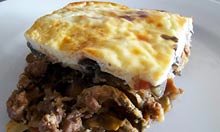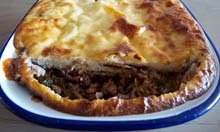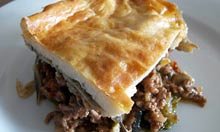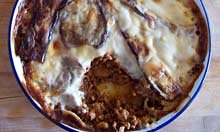It’s funny how quick the British are to forget the damp privations of our dreary winters. The first sunny day of spring always takes us by collective surprise yet soon we’re throwing a strop if it dares to rain on our new espadrilles. Moussaka seems the perfect choice for this time of year, like bouillabaisse, or parmigiana; a dish which simultaneously manages to taste of sunshine, and boast warming qualities quite sufficient to see you through a spring shower.
It’s not just a Greek dish – the name is Arabic, and it’s known, in various forms, from Egypt to Romania. But the moussaka we know best is the one we brought back with us from a thousand Shirley Valentine-esque Ionian holidays. Meat, aubergines and a wobbly bechamel sauce should be the principal ingredients – but in what combination?
Meat with approval

Hugh Fearnley-Whittingstall recipe moussaka. Photograph: Felicity Cloake
Until I talked to Elisavet Sotiriadou, who teaches Greek cookery classes in London, I assumed there was little debate over the meat. Moussaka, like souvlaki, equalled lamb as far as I was concerned. But Elisavet, who modestly admits that she makes moussaka nearly as good as her mother’s, has news for me. “The mince used is veal, or pork and veal, but here in the UK, it’s very hard to find veal and if you do it’s too expensive or people don’t like to eat it, so hence [I use] beef mince”.
Elizabeth David suggests beef in A Book of Mediterranean Food, and Tessa Kiros goes for a beef and pork mix in her aunt’s recipe, published in Falling Cloudberries. Everyone else, including Theodore Kyriakou, specifies lamb – and that in a book entitled The Real Greek at Home. I agree that sweet, robustly-flavoured lamb seems much more at home with the cinnamon and nutmeg in the recipe than pork or beef. Forgive me Elisavet, but I’m sticking with lamb.
Whatever meat is used, it must be minced. Hugh Fearnley-Whittingstall, never one to shy away from some hard work, suggests using up cold roast lamb: indeed, “the roasting of the meat gives a depth of flavour that is hard to achieve with raw meat”. Not possessing a mincing machine, or vast reserves of patience, my chunks are coarser than Hugh might deem appropriate, but I like the result – it gives the dish more body. Flavourwise, however, there doesn’t seem to be a vast amount of difference, so although I’ll definitely keep this in mind as a vehicle for leftovers, I’m going to stick with the ready minced.
A matter of sauce

Prawn Cocktail Years recipe moussaka. Photograph: Felicity Cloake
What most, if not all moussakas have in common is a tomato sauce – indeed, according to the Oxford Companion to Food, the name comes from Arabic “to moisten”, referring to this very ingredient. Theodore and Tessa stick close to tradition, and use tomato passata, or perasti, as it’s known in Greece, while Hugh and Simon Hopkinson and Lindsey Bareham in their book The Prawn Cocktail Years, opt for tomato purée.
Theodore and Tessa’s are both quite light and saucy, and I think perasti’s a winner until I taste the others. Rich with the red wine included in both (Tessa goes for white, Theodore specifies red only “if needed”), sweet with spice and intensely flavoured, Hugh and the Prawn Cocktail duo knock the Greeks right out of the ring.
The all-important aubergine

Nigel Slater recipe moussaka. Photograph: Felicity Cloake
The other principal ingredient is, of course, aubergine. This, in my opinion, is what really sets it apart from others of its ilk such as the shepherd’s pie or the lasagne: layers of meltingly soft, every so slightly bitter purple and pale green slices, which all too often sadly, exude oil with every bite. To prevent this, pre-salting is de rigeur for everyone apart from Theodore – as Nigel explains, this helps them to “relax, allowing them to soak up less oil.” (And what kind of monster would deny their aubergines a little R&R in the colander?)
Aubergines are notorious for their sponge-like qualities – I believe you could pour in most of a bottle of oil during cooking, and end up with none left in the pan – and indeed, Theodore’s are notably greasy, even when patted dry before use. What I find more off-putting, however, is the frying most recipes demand: given the meat is simmering away in another at the same time, this necessitates the use of two frying pans. Hugh’s baked aubergines, then, are a godsend: no need to salt them, as he does – simply brush with oil and stick in the already-heating oven for 25 minutes until soft, but pleasantly light on the grease front. After all, the lamb has enough fat in it to ensure the dish will never be dry.
How to top it

Theodore Kyriakou recipe moussaka. Photograph: Felicity Cloake
My mum always tops her moussaka with a simple bechamel – butter, flour, milk – an approach also favoured by Nigel Slater and Tessa Kiros. Hugh claims an “authentic custardy top, rather than just a cheesy bechamel” with hot milk whisked into eggs, and bulked out with Greek yoghurt – but actually the yoghurt makes this a bit grainy.
Much better is the compromise hit on by both Theodore Kyriakou and the Prawn Cocktail Years’ authors, which involves stirring beaten eggs into a finished bechamel, so it puffs up beautifully in the oven. I’m not going to bother infusing the milk with an onion and bay leaf as Simon and Lindsey do though: once it’s laden with nutmeg (although not an entire nutmeg as quite extraordinarily suggested by Theodore), there seems little point.
A bechamel and egg combination also gets Elisavet’s vote, along with grated cheese. Hugh and Theodore use kefalotyri, a hard sheep’s milk variety (with Hugh suggesting a parmesan / gruyère mix as a substitute), and Simon and Lindsey go for feta. I can’t get the feta to melt properly, and kefalotyri proves difficult to come by (Elisavet recommends substituting a mature cheddar), but pecorino, another aged ewe’s milk cheese adds a salty, sheepy quality that’s perfect with the lamb.
Extras

Tessa Kiros recipe moussaka. Photograph: Felicity Cloake
Tessa includes a layer of potatoes, which, on top of the bechamel makes the dish a bit stodgy, although I can see that, in the winter, it might be a nice addition. Theodore goes for courgettes as well as aubergines, but I can’t see that they add anything, and they need to be cooked separately, so I dispense with that idea sharpish.
Theodore’s recipe concludes with the instruction to let it rest. Elisavet explains the thinking: “If you’ve made moussaka, you know it needs to set for a bit, before cutting up your piece and serving. If too hot you won’t get a well cut out square piece, it will fall apart.” After making, and photographing, six moussakas, I agree: and I’d add that, as with many aubergine dishes, the flavours seem more intense when it isn’t piping hot.
Cinnamon is a must (only Nigel eschews it), and I’ve been generous with it – but oregano and parsley, as used by Tessa Kiros, add a pleasant whiff of sun-baked herbaceousness to proceedings. Along with a big hit of garlic, they bring a taste of the Mediterranean to the dish. Which is just what I’m after.
Felicity’s perfect moussaka

Felicity’s perfect moussaka. Photograph: Felicity Cloake
Serves 4, generously
4 tbsp olive oil
3 medium or 2 large aubergines, sliced
1 large onion, finely chopped
4 cloves of garlic, finely chopped
1.5 tsp cinnamon
1 tsp dried oregano
500g minced lamb
2 tbsp tomato purée, mixed with 150ml water
150ml red wine
Small bunch of flat-leaf parsley, chopped
For the bechamel:
500ml milk
60g butter
60g plain flour
50g kefalotyri or pecorino cheese, grated
2 eggs, beaten
Nutmeg, to grate
1. Pre-heat the oven to 180C. Cut the aubergines lengthways into 0.5cm slices, and put them on to oiled baking sheets. Brush with olive oil and season. Bake for about 25 minutes until soft, golden and floppy.
2. Meanwhile, put 2 tbsp olive oil into a large frying pan over a medium high heat and cook the onion until soft. Add the garlic, cinnamon and oregano and cook for a further couple of minutes, then stir in the lamb. Turn up the heat slightly, and brown the lamb well, cooking until the mixture is quite dry. Stir in the tomato and wine, bring to a simmer, then turn the heat down low and cook for 30–40 minutes until most of the liquid has evaporated. Season and stir in the parsley.
3. Meanwhile, make the bechamel. Bring the milk to just below boiling point, and melt the butter in another saucepan. Stir the flour into the butter and cook for a couple of minutes, then gradually whisk in the hot milk. Cook until you have a thick sauce, then stir in the cheese until melted. Take off the heat and allow to cool slightly, then beat in the eggs, salt to taste and slightly more nutmeg than you might think wise (it’s a strong flavour, but you need a heft of it in this dish I think – half a teaspoon at least).
4. Arrange a third of the aubergines in the base of an oven dish, and top with half the meat. Repeat these layers, then finish off with a layer of aubergine, and top with the sauce. Bake for about 45 minutes until well browned, and then leave to cool for half an hour before serving.
What kind of moussaka floats your pedalo – does the Greek version have the monopoly here for good reason? Where do you stand on the question of beef v lamb … or do you prefer vegetables? And which other dishes have you brought back from your hols?
Source:theguardian.com
